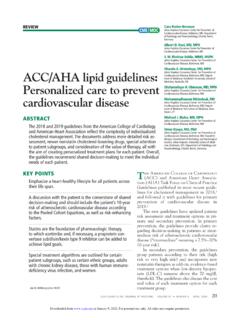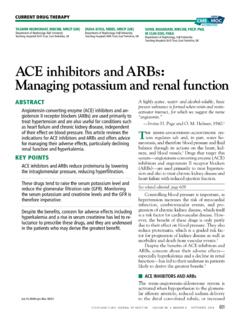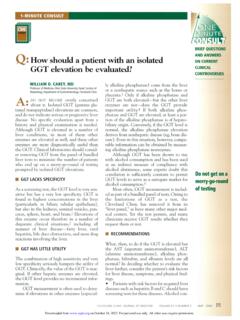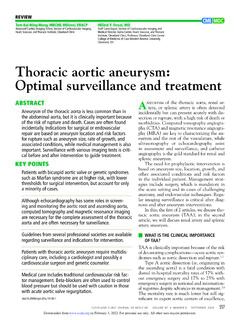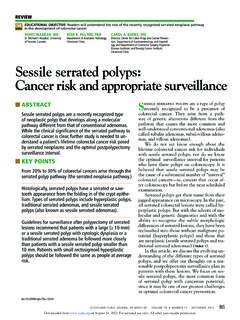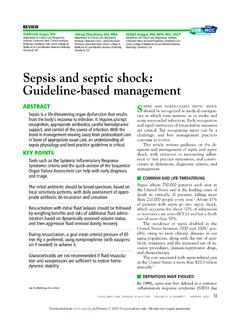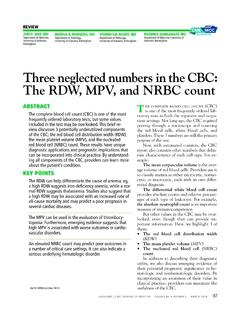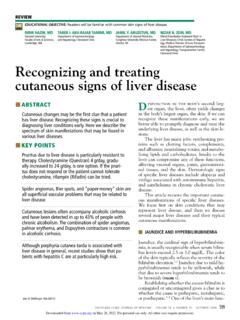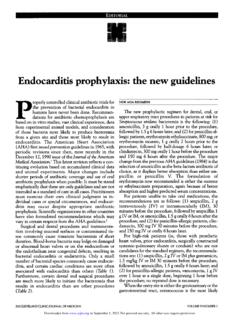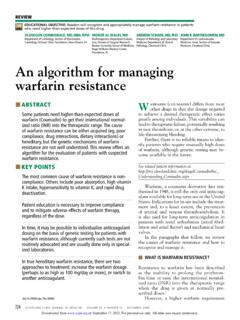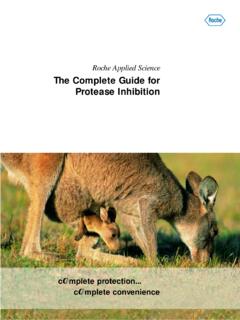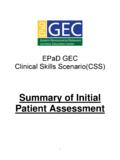Transcription of Can an ARB be given to patients who have had angioedema …
1 Q: Can an ARB be given to patients who have had angioedema on an ACE inhibitor?Prashant sharma, mDDepartment of Hospital Internal Medicine, Mayo Clinic, Rochester, MNVijaiganesh nagarajan, mDDepartment of Cardiovascular Medicine, University of Virginia, Charlottesvillecurrent evidence suggests no ab-solute contraindication to angiotensin receptor blockers (ARBs) in patients who have had angioedema attributable to an angioten-sin-converting enzyme (ACE) inhibitor. How-ever, since ARBs can also cause angioedema , they should be prescribed with extreme caution after a thorough risk-benefit analysis and after educating the patient to watch for signs of an-gioedema while taking the drug.
2 A growing problemAngioedema is a potentially life-threatening swelling of the skin and subcutaneous tissues, often affecting the lips and tongue (FIGURE 1), and in some cases interfering with breathing and requiring The incidence rate of angioedema in patients taking ACE inhibitors ranges from to 4 Al-though this rate may seem low, the widespread and growing use of ACE inhibitors and ARBs in patients with diabetes, diabetic nephropa-thy, and congestive heart failure5 makes angio- edema fairly common in clinical practice. ACE inhibitor-induced angioedema most commonly occurs within days of initiating therapy, but it also may occur weeks, months, or even years after the start of Pa-tients who are over age 65, black, or female are at higher risk, as are renal transplant re-cipients taking mTOR inhibitors such as siro-limus.
3 Diabetes appears to be associated with a lower ,6,7 This adverse reaction to ACE inhibitors is thought to be a class side effect, and the future use of this class of drugs would be ,9 ACE inhibitors cause angioedema by di-rect interference with the degradation of bra-dykinin, thereby increasing bradykinin levels and potentiating its biologic effect, leading to increased vascular permeability, inflamma-tion, and activation of evidence to support the use of arbsACE inhibitors and ARBs both block the renin-angiotensin-aldosterone pathway and confer similar advantages in patients with congestive heart failure, renal failure, and diabetes.
4 But since ARBs directly inhibit the CLEVELAND CLINIC JOURNAL OF MEDICINE VOLUME 80 NUMBER 12 DECEMBER 2013 7551-MINUTE answers to sPecific clinical questionsA:FIGURE 1. angioedema affecting the tongue in a man tak-ing an angiotensin-converting enzyme inhibitor. Involve-ment of the lips and the tongue can be life-threatening, requiring OBJECTIVE: Readers will weigh the risks and possible benefits of substituting an angiotensin receptor blocker for an angiotensin-converting enzyme inhibitor after angioedemaCREDITCME on December 20, 2022. For personal use only. All other uses require from 756 CLEVELAND CLINIC JOURNAL OF MEDICINE VOLUME 80 NUMBER 12 DECEMBER 2013angioedemaangiotensin receptor and do not interfere with bradykinin degradation, how they cause an-gioedema is unclear, and clinicians have ques-tioned whether these agents might be used safely in patients who have had angioedema on an ACE inhibitor.
5 In a large meta-analysis of randomized clinical trials, Makani et al2 investigated the risk of angioedema with ARB use in 35,479 patients and compared this with other com-monly used antihypertensive drugs. The weighted incidence of angioedema was with an ACE inhibitor, with an ARB, and with In seven trials in-cluded in this study that compared ARBs with placebo, there was no significant difference in the risk of angioedema . Even in such a large study, the event rate was small, making defi-nite conclusions difficult. In a retrospective observational study of 4 million patients by Toh et al,3 patients on be-ta-blockers were used as a reference, and pro-pensity scoring was used to estimate the hazard ratio of angioedema separately for drugs target-ing the renin-angiotensin-aldosterone system, including ACE inhibitors and ARBs.
6 The risk of angioedema , as measured by the cumula-tive incidence and incidence rate, was highest for ACE inhibitors and was similar between ARBs and beta-blockers. The risk of serious angioedema was three times higher with ACE inhibitors than with beta-blockers, and there was no higher risk of serious angioedema with ARBs than with Looking specifically at the use of ARBs in patients who developed angioedema on an ACE inhibitor, Haymore et al10 performed a meta-analysis evaluating only three studies that showed the estimated risk of angioedema with an ARB was between and in patients with a history of ACE inhibitor-induced angioedema .
7 Later, when the results of the Telmisartan Randomised Assessment Study in ACE Intolerant Subjects With Car-diovascular Disease trial11 were published, the previous meta-analysis was updated12: the risk of angioedema with an ARB was only (95% confidence interval 0% ), and there was no statistically significant difference in the odds (odds ratio ; 95% confidence interval 17) of angioedema between ARBs and ,12 Again, these results should be interpreted with caution, as only two patients in the ARB (telmisartan) group and three patients in the placebo group devel-oped angioedema . In another review, Beavers et al13 advised that the prescribing practitioner should care-fully perform a risk-benefit analysis before substituting an ARB in patients with ACE in-hibitor-induced angioedema .
8 They concluded that an ARB could be considered in patients who are likely to have a large clinical benefit from an ARB, such as those with heart failure. They also suggested that angioedema related to ARBs was less severe and occurred earlier than with that linked to ACE inhibitors . No large clinical trial has yet been specifi-cally designed to address the use of ARBs in patients with a history of ACE inhibitor-in-duced angioedema . The package insert for the ARB losartan mentions that the risk of this adverse reaction might be higher in patients who have had angioedema on an ACE in-hibitor. However, the issue of recurrent angio- edema is not further addressed for this or other commonly used ARBs.
9 General recommendationsThe mechanisms of ARB-induced angioede-ma are yet unknown. However, studies have shown that the incidence of angioedema while on an ARB is low and is probably com-parable to that of ,3,12 14 And since ARBs share many of the cardiac and renal protective effects of ACE inhibitors , ARBs may be beneficial for patients who discontinue an ACE inhibitor because of adverse effects including ,15,16 Based on the dis-cussion above, there is no clear evidence to suggest that ARBs are contraindicated in such patients , especially if there is a compelling in-dication for an ARB.
10 The National Kidney Foundation Kid-ney Disease Outcomes Quality Initiative (NKF KDOQI) guidelines on hypertension in chronic kidney disease recommend caution when substituting an ARB for an ACE inhibi-tor after The joint guidelines of the American College of Cardiology and American Heart Association (ACC/AHA) for the diagnosis and management of heart failure in adults advise extreme caution. 9,16 The widespread use of ACE inhibitors makes angioedema fairly common in clinical practice on December 20, 2022. For personal use only. All other uses require from CLEVELAND CLINIC JOURNAL OF MEDICINE VOLUME 80 NUMBER 12 DECEMBER 2013757 Sharma and nagarajan The risks and benefits of ARB therapy in this setting should be analyzed by the prescrib-ing physician and discussed with the patient.
